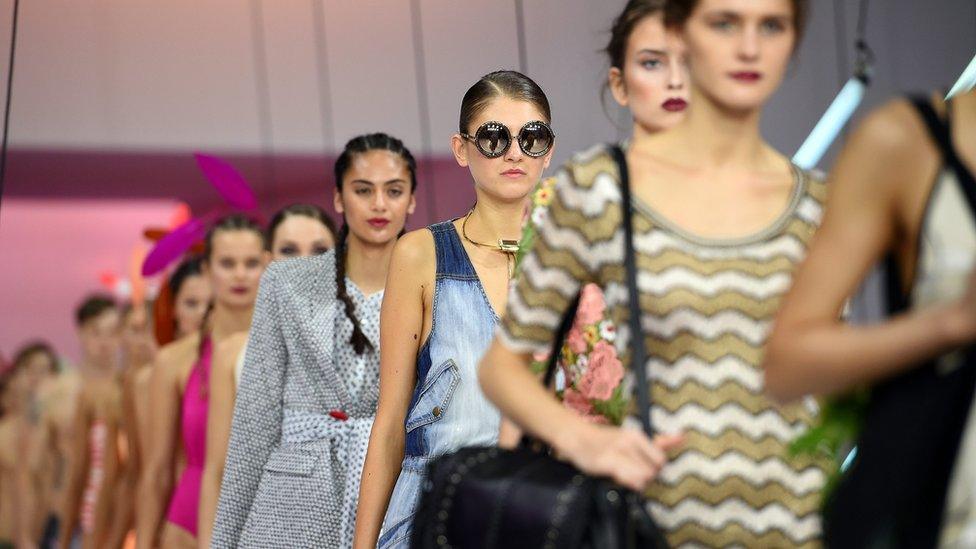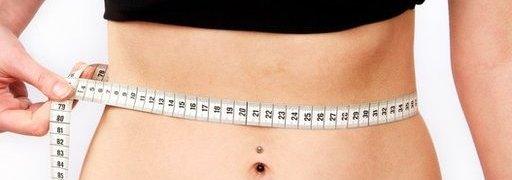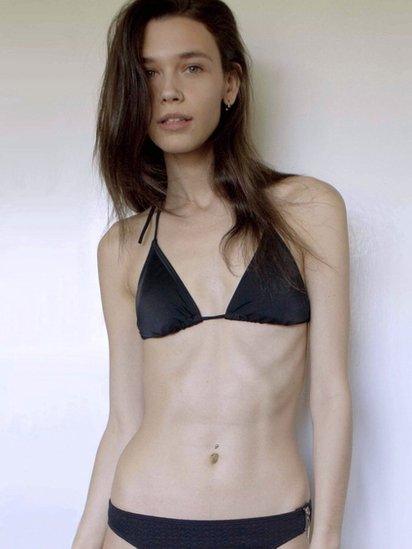Fashion designers 'must make sample sizes bigger'
- Published

Campaigners say designers' small sample sizes are at the "root" of eating disorders
Designers at London Fashion Week should show at least two sample sizes, one of which should be a UK size 12 or above, the Women's Equality Party has said.
Its #NoSizeFitsAll campaign has called on the British Fashion Council to lead the way for healthy body images at the event, which starts on 15 September.
The WEP said: "Designers churn out sample sizes so small that models have to starve themselves to fit into them."
The BFC said it takes the issues the campaign raises "very seriously".
A UK size 16 or above is considered "plus-size", although there is no industry-wide standard for the term.
The average UK size is 12. Sample size clothing worn by models on catwalks tends to be a UK size eight.
Sophie Walker, leader of the WEP, told the BBC that the campaign aimed to tackle the growing number of women and girls suffering from eating disorders by going to the "root of the problem" - sample sizes from fashion designers.

What's in a size?

UK dress sizes vary slightly according to the manufacturer. But if you take Marks & Spencer guidelines, external - which start at a size 6, you can estimate the lower sizes by looking at the difference between the larger sizes.
Size 6 Bust 30.75 inches, waist 24 inches, hips 33.75 inches
Size 12 Bust 36.25 inches, waist 29.5 inches, hips 39.5 inches
Size 18 Bust 42.5 inches, waist 36.25 inches, hips 45.25 inches
Size 24 Bust 49.5 inches, waist 43.25 inches, hips 52.5 inches

Ms Walker said 28 studies from the UK, Europe, North America and Australia had found that images in the media of models had a direct impact on how women viewed their bodies, with negative body image putting someone at a considerably heightened risk of developing an eating disorder.
The campaign is also calling for body image education to be mandatory in schools, for a change in the law to ensure models are of a healthy weight and for magazines to include one plus-sized spread in every issue.
With less than a fortnight to go until the opening of London Fashion Week, Ms Walker said the British Fashion Council (BFC) "has got to raise their game".

Eating disorders
Research from the eating disorders charity Beat suggests more than 725,000 people in the UK are affected by an eating disorder.
The National Institute of Health and Care Excellence estimates about 11% of those affected by an eating disorder are male.
The Health and Care Information Centre published figures in February 2014 showing an 8% rise in the number of inpatient hospital admissions in the 12 months to October 2013.
It is estimated that about 40% of people with an eating disorder have bulimia, 10% anorexia, and the rest other conditions, such as binge-eating disorder.
Many eating disorders develop during adolescence, but it is not at all unusual for people to develop eating disorders earlier or later in life.
Source: Beat - Beating eating disorders.

'Breaking rules'
Back in 2009, Vogue's UK editor Alexandra Shulman criticised fashion houses for sending sample clothes too small for many models to wear.
In the magazine house's statement, Vogue editors said they would encourage designers "to consider the consequences of unrealistically small sample sizes of their clothing, which limits the range of women who can be photographed in their clothes, and encourages the use of extremely thin models".
But Ms Walker said the fashion industry had been "very very reluctant to move on this".
US fashion blogger Liz Black said recently that designers' reasons for creating tiny clothes range from "everything from as a cost-cutting measure, to feeling forced into the standard by the model options provided to them from agencies, to wanting people to see the clothes, not the woman."
Whatever the reason, she wrote on her blog P.S. It's Fashion, external: "It still forces an exclusive atmosphere that lacks a level of diversity."
Ms Walker added: "They've bought into their own myth that creativity relies on these tiny sizes... but creativity is about breaking rules."

Rosie Nelson was asked to lose weight by a top modelling agency
Caroline Rush, chief executive of the BFC, said: "The #NoSizeFitsAll campaign addresses three key issues around image, cost to public health and body image.
"This is something that we take very seriously and we support a campaign that raises awareness around public health and promotes a positive perception around body image and eating disorders in schools around the country."
She said that the BFC has already implemented a number of measures at London Fashion Week, including banning models under the age of 16 and providing food and drink backstage.
She added: "As a part of their contracts all designers need to commit to these measures."
Some 83 designers will be featuring their new collections on the catwalk and show schedule, while more than 150 designers will showcase their designs in the trade Designer Showroom.
According to the BFC more than 5,000 members of the press, buyers and other visitors attend the event every season from across the globe.
'I was skin and bone'
One of the campaign's leading supporters is the model Rosie Nelson.
Ms Nelson was a size eight when she says she was told by a top agency to get thinner. She previously told the BBC that she dieted and exercised until her ribs were sticking out.
"I went back four months later and they said, 'We just want you to get down to the bone.' I just sat there and thought, 'I can't lose any more weight, I've lost pretty much everything.' I was skin and bone at that point," she said.

Jada Sezer created a Vogue-style shoot using herself, a size 16, as the model
Ms Nelson, from Sandhurst, Berkshire, started a petition calling for better healthcare in the modelling industry, which attracted 124,562 signatures.
She presented it to Parliament with the Conservative MP Caroline Nokes in December, launching an inquiry into healthcare in the modelling industry.
It was due to report in March, but a spokesman for Ms Nokes told the BBC: "The report into the inquiry has been delayed because of a large influx in the number of people wanting to share their experiences."
He said there had been worldwide interest in it and that they would inform people of the progress of the inquiry in due course.
Another supporter of the campaign is the model Jada Sezer, who is about to launch her own fashion line for women sized 6 to 26.
An ambassador for the charity Young Minds, she created her own Vogue-style photo project connecting with photographers and recreating editorials with her - a UK size 16 - as the model.
When she posted the images online they went viral, gathering 80,000 followers. She was invited to model for Evans in London Fashion Week's first ever plus-size show in 2014 and is currently the face of a L'Oreal campaign.